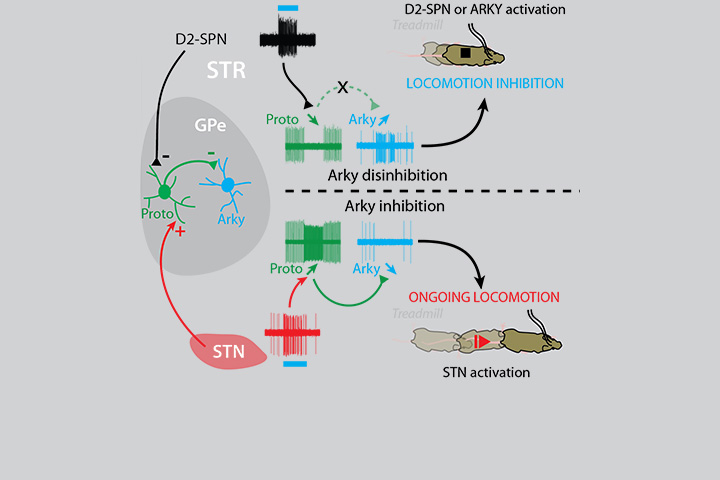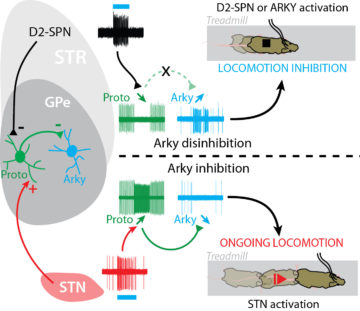
Jérôme Baufreton and Nicolas Mallet in Current Biology
The basal ganglia play a crucial role in controlling locomotion as best evinced by the motor symptoms present in Parkinson’s disease following their dysfunctions. However, the neuronal mechanisms involved in such locomotor control are not precisely known. In this paper authored by Asier Aristieta et al., we discovered a novel basal ganglia circuit mechanism that, when recruited, causes a powerful and global state of motor suppression. Our work calls for a re-evaluation of basal ganglia functional organization that should account for the critical role played by globus pallidus arkypallidal neurons in action selection/cancellation. This publication results from co-investigations within two teams of the IMN (J. Baufreton and N. Mallet) and a collaboration with the AniMotion collaborative platform from INCIA (G. Barrière/G. Courtand).
Abstract
 Basal ganglia (BG) inhibit movements through two independent circuits: the striatal-indirect and the subthalamic nucleus-hyperdirect pathways. Both pathways exert opposite effects onto external globus pallidus (GP) neurons which functional importance as a relay has changed drastically with the discovery of two distinct cell types, namely the prototypic and the arkypallidal neurons. However, little is known about the synaptic connectivity scheme of different GP neurons towards both motor-suppressing pathways, as well as how opposite changes in GP neuronal activity relate to locomotion inhibition. Here, we optogenetically dissect the inputs organizations of prototypic and arkypallidal neurons, and further define the circuit mechanism and behavioural outcome associated with activation of the indirect or the hyperdirect pathways. This work reveals that arkypallidal neurons are part of a novel disynaptic feedback loop differentially recruited by the indirect or the hyperdirect pathways and that broadcast inhibitory control onto locomotion only when arkypallidal neurons increased their activity.
Basal ganglia (BG) inhibit movements through two independent circuits: the striatal-indirect and the subthalamic nucleus-hyperdirect pathways. Both pathways exert opposite effects onto external globus pallidus (GP) neurons which functional importance as a relay has changed drastically with the discovery of two distinct cell types, namely the prototypic and the arkypallidal neurons. However, little is known about the synaptic connectivity scheme of different GP neurons towards both motor-suppressing pathways, as well as how opposite changes in GP neuronal activity relate to locomotion inhibition. Here, we optogenetically dissect the inputs organizations of prototypic and arkypallidal neurons, and further define the circuit mechanism and behavioural outcome associated with activation of the indirect or the hyperdirect pathways. This work reveals that arkypallidal neurons are part of a novel disynaptic feedback loop differentially recruited by the indirect or the hyperdirect pathways and that broadcast inhibitory control onto locomotion only when arkypallidal neurons increased their activity.
In this article, the authors show a cell-type specific connectivity within the external globus pallidus which lead to opposite activity pattern between prototypic and arkypallidal neurons and opposite outcome on movement inhibition. Selective optogenetic activation of arkypallidal neurons is sufficient to stop locomotion on a treadmill and uncover the key function of these neurons is suppressing ongoing locomotion (see video).
This video illustrates the powerful inhibitory effect that Arkypallidal neurons optogenetic activation has on the locomotor activity of a mice walking on a motorized treadmill. The locomotor video sequence was captured bilaterally (i.e. left and right view) at 250 frames/seconde.
Reference
Aristieta A, Barresi M, Azizpour Lindi S, Barrière G, Courtand G, de la Crompe B, Guilhemsang L, Gauthier S, Fioramonti S, Baufreton J, Mallet NP.
A Disynaptic Circuit in the Globus Pallidus Controls Locomotion Inhibition.
Curr Biol. 2020 Dec 3:S0960-9822(20)31694-8.
doi: 10.1016/j.cub.2020.11.019
Contact
Jérôme Baufreton,
Team « Dopamine et Assemblées Neuronales »
Institut des Maladies Neurodégénératives, UMR5293, CNRS, Université de Bordeaux
Nicolas Mallet,
Team « Physiologie et physiopathologie des fonctions exécutives »
Institut des Maladies Neurodégénératives, UMR5293, CNRS, Université de Bordeaux
Mise à jour: 22/12/20
